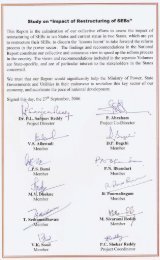BASANIA HEP_PFR - Ministry of Power
BASANIA HEP_PFR - Ministry of Power
BASANIA HEP_PFR - Ministry of Power
Create successful ePaper yourself
Turn your PDF publications into a flip-book with our unique Google optimized e-Paper software.
uS'kuy gkbMªksbySfDVªd<br />
ikoj dkjiksjs'ku fyñ<br />
Preliminary Feasibility Report<br />
Basania HE Project 3 X 30 MW<br />
population <strong>of</strong> the district is 451193, out <strong>of</strong> which 223691 are males and 227502 are<br />
females.<br />
Ethnographic details<br />
Gonds and Baigas are most significant tribes in the district. Amongst them Gonds are<br />
well settled and economically better than any other communities. Gonds were earlier<br />
mostly forest-dwellers but are at present settled agriculturists. Their staple food is millet<br />
and boiled rice. Both vegetarian and non-vegetarian food is common amongst them.<br />
The clans are usually named after some animals or plants. Common clans among the<br />
Gonds are Markam (Mango tree), Tekam (Teak tree), Netam (the dog), Warkara (wild<br />
cat) and so on. The Gonds have highly developed aesthetic sense. They indulge in<br />
merry making which is manifested in dancing and singing and in celebration <strong>of</strong> festivals<br />
like Holi, Megnath jayanti etc. The dead person, whether male or female is buried with<br />
face upward, head to the north and feet to the south. Folk dance, folk songs and folk<br />
music play vital role in the culture life <strong>of</strong> Gonds. It is through music and dance that they<br />
keep themselves occupied in the evenings. Folk music and dance give expression to<br />
their innermost feelings, their love and sorrows, their natural affections and ideas. Folk<br />
dances <strong>of</strong> Gonds are popularly called as Karma. Festivals celebrated by Gonds are<br />
Hareli- festival <strong>of</strong> rain, Khyania, Rakhi, Dashera, Mela Madai, Chait Gal and Nawa.<br />
Agriculture<br />
Major crops cultivated in the district are paddy, wheat, maize and jowar amongst<br />
cereals; tur, urad and moong amongst pulses, while soyabean , groundnut and<br />
mustard amongst oilseeds. Commercial crops <strong>of</strong> the district are cotton and sugarcane.<br />
Horticulture produce <strong>of</strong> the district is papaya, banana, oranges, mango and grapes.<br />
Literacy<br />
District Mandla has the total literacy rate <strong>of</strong> 59.85 % . Percentage <strong>of</strong> male and female<br />
literates in the district are 74.38% and 45.39% respectively. Total literacy rate in the<br />
rural areas <strong>of</strong> the district is 56.71%. 72.11% males and 41.50% females in the rural<br />
areas are literate. Total literacy rate in the urban areas <strong>of</strong> the district is 85.83%.<br />
92.65% males and 78.67% females in the urban areas <strong>of</strong> the district are literate.<br />
NH/CON/229 13 01/2004

















